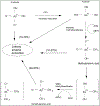State of the science review of the health effects of inorganic arsenic: Perspectives for future research
- PMID: 30511785
- PMCID: PMC6328315
- DOI: 10.1002/tox.22673
State of the science review of the health effects of inorganic arsenic: Perspectives for future research
Abstract
Human exposure to inorganic arsenic (iAs) is a global health issue. Although there is strong evidence for iAs-induced toxicity at higher levels of exposure, many epidemiological studies evaluating its effects at low exposure levels have reported mixed results. We comprehensively reviewed the literature and evaluated the scientific knowledge on human exposure to arsenic, mechanisms of action, systemic and carcinogenic effects, risk characterization, and regulatory guidelines. We identified areas where additional research is needed. These priority areas include: (1) further development of animal models of iAs carcinogenicity to identify molecular events involved in iAs carcinogenicity; (2) characterization of underlying mechanisms of iAs toxicity; (3) assessment of gender-specific susceptibilities and other factors that modulate arsenic metabolism; (4) sufficiently powered epidemiological studies to ascertain relationship between iAs exposure and reproductive/developmental effects; (5) evaluation of genetic/epigenetic determinants of iAs effects in children; and (6) epidemiological studies of people chronically exposed to low iAs concentrations.
Keywords: adverse health effects; arsenic; future research directions; knowledge gaps; mechanisms of action.
© 2018 Wiley Periodicals, Inc.
Conflict of interest statement
CONFLICT OF INTEREST
All authors declare no competing and/or financial conflict of interest. They have read the paper, and agreed the work to be submitted to the Environmental Toxicology journal.
Figures
Similar articles
-
Comparative toxicity of trivalent and pentavalent inorganic and methylated arsenicals in rat and human cells.Arch Toxicol. 2000 Aug;74(6):289-99. doi: 10.1007/s002040000134. Arch Toxicol. 2000. PMID: 11005674
-
Developmental neurotoxicity of inorganic arsenic exposure in Sprague-Dawley rats.Neurotoxicol Teratol. 2019 Mar-Apr;72:49-57. doi: 10.1016/j.ntt.2019.01.007. Epub 2019 Feb 6. Neurotoxicol Teratol. 2019. PMID: 30738146
-
Biotransformation of dietary inorganic arsenic in a freshwater fish Carassius auratus and the unique association between arsenic dimethylation and oxidative damage.J Hazard Mater. 2020 Jun 5;391:122153. doi: 10.1016/j.jhazmat.2020.122153. Epub 2020 Jan 21. J Hazard Mater. 2020. PMID: 32044628
-
Biomarkers of exposure: a case study with inorganic arsenic.Environ Health Perspect. 2006 Nov;114(11):1790-6. doi: 10.1289/ehp.9058. Environ Health Perspect. 2006. PMID: 17107869 Free PMC article. Review.
-
Developmental and reproductive toxicity of inorganic arsenic: animal studies and human concerns.J Toxicol Environ Health B Crit Rev. 1998 Jul-Sep;1(3):199-241. doi: 10.1080/10937409809524552. J Toxicol Environ Health B Crit Rev. 1998. PMID: 9644328 Review.
Cited by
-
Design of a Whole-Cell Biosensor Based on Bacillus subtilis Spores and the Green Fluorescent Protein To Monitor Arsenic.Microbiol Spectr. 2023 Aug 17;11(4):e0043223. doi: 10.1128/spectrum.00432-23. Epub 2023 Jun 7. Microbiol Spectr. 2023. PMID: 37284752 Free PMC article.
-
Mechanistic understanding of the toxic effects of arsenic and warfare arsenicals on human health and environment.Cell Biol Toxicol. 2023 Feb;39(1):85-110. doi: 10.1007/s10565-022-09710-8. Epub 2022 Apr 1. Cell Biol Toxicol. 2023. PMID: 35362847 Free PMC article. Review.
-
NaAsO2 regulates TLR4/MyD88/NF-κB signaling pathway through DNMT1/SOCS1 to cause apoptosis and inflammation in hepatic BRL-3A cells.Biol Trace Elem Res. 2024 Jan;202(1):258-267. doi: 10.1007/s12011-023-03648-6. Epub 2023 Mar 29. Biol Trace Elem Res. 2024. PMID: 36988786
-
Iron Oxide Powders Containing Arsenic from Water Treatment Processes Mixed with Cement as Environmental and Structural Solution.Materials (Basel). 2025 Jan 27;18(3):582. doi: 10.3390/ma18030582. Materials (Basel). 2025. PMID: 39942248 Free PMC article.
-
Human biomonitoring of essential and toxic trace elements (heavy metals and metalloids) in urine of children, teenagers, and young adults from a Central European Cohort in the Czech Republic.J Expo Sci Environ Epidemiol. 2024 Oct 16. doi: 10.1038/s41370-024-00724-4. Online ahead of print. J Expo Sci Environ Epidemiol. 2024. PMID: 39414997
References
-
- Wu MM, Kuo TL, Hwang YH. Dose-response relation between arsenic concentration in well water and mortality from cancers and vascular diseases. Am J Epidemiol. 1989;130:1123–1132. - PubMed
-
- NRC (National Research Council). Arsenic in Drinking Water: Update. Washington DC., National Academy Press; 2001.
-
- Tchounwou PB, Udensi KU, Isokpehi RD, Yedjou CG, Kumar S. Arsenic and cancer Chapter 23 in Handbook of Arsenic Toxicology. Flora SJS (Ed). Elsevier Inc; London: pp 533–555. 2015.
-
- Wei B, Yu J, Kong C, Li H, Yang L, Xia Y, Wu K. Effects of arsenic methylation and metabolism on the changes of arsenic-related skin lesions. Environ Sci Pollut Res Int. 2018;25(24):24394–24402. - PubMed
-
- Ravenscroft P, Brammer H, Richards K. Arsenic Pollution: A Global Synthesis. Wiley-Blackwell; 2009;Pp 4–618.
Publication types
MeSH terms
Substances
Grants and funding
LinkOut - more resources
Full Text Sources



